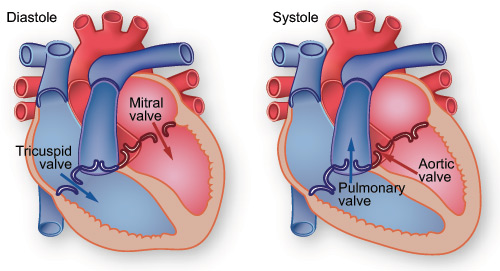Related terms: heart valves, valve insufficiency, valve regurgitation, valve stenosis,
valvular heart disease
Every time your heart beats, blood flows into, through, and out of your heart. In fact, your heart moves about 100 gallons (379 liters) of blood through your body every hour.
Blood is pumped through your heart in only one direction. Heart valves play key roles in this one-way blood flow, opening and closing with each heartbeat. Pressure changes behind and in front of the valves allow them to open their flap-like "doors" (called cusps or leaflets) at just the right time, then close them tightly to prevent a backflow of blood.
There are 4 valves in the heart: tricuspid, pulmonary, mitral, and aortic.

Two types of problems can disrupt blood flow though the valves: regurgitation or stenosis.
Regurgitation is also called insufficiency or incompetence. Regurgitation happens when a valve doesn't close properly and blood leaks backward instead of moving in the proper one-way flow. If too much blood flows backward, only a small amount can travel forward to your body's organs. Your heart tries to make up for this by working harder, but with time your heart will become enlarged (dilated) and less able to pump blood through your body.
Stenosis (narrowing) happens when the leaflets do not open wide enough and only a small amount of blood can flow through the valve. This narrowing results when the leaflets thicken, stiffen, or fuse together. Because of the narrowed valve, your heart must work harder to move blood through your body.
What causes valve disease?
Before doctors started giving their patients antibiotics, rheumatic fever was the single biggest cause of valve disease. Today, the cause of valve disease is most likely linked to one of the following:
- A weakening of the valve tissue caused by energy changes in the body. This is called myxomatous degeneration. It happens most often in elderly patients and commonly affects the mitral valve.
- A buildup of calcium on the aortic or mitral valves, which causes the valves to thicken. This is called calcific degeneration.
- An irregularly shaped aortic valve or a narrowed mitral valve. This is usually a congenital defect, which means that most people who have it were born with it.
- Use of the anti-obesity medicines fen-phen and Redux, which were removed from the market after being linked to heart valve disease.
- An infection in the lining of the heart's walls and valves (the endocardium). This is called infective endocarditis.
- Coronary artery disease.
- Heart attack.
What are the symptoms?
Symptoms depend on the patient and the type and severity of valve disease. Some patients have no symptoms at all. In other cases, valve disease may take its toll over many years. In time, patients may develop congestive heart failure. Also, valve disease may lead to heart muscle disease (cardiomyopathy), an irregular heartbeat (arrhythmia), and blood clots.
See also on this site:
How is valve disease diagnosed?
Your doctor can tell if you have valve disease by listening to your heart with a stethoscope. Doctors can listen for the distinct clicking sounds or murmurs of valve disease. Other diagnostic tests your doctor may order include
- A chest x-ray, which can show if your heart is enlarged. This can happen if a valve is not working properly.
- Echocardiography, which can produce a picture of the thickness of your heart's walls, your valves' shape and action, and the size of your valve openings. Doppler echocardiography (ultrasound) can be used to find out how severe the narrowing (stenosis) or backflow (regurgitation) of blood is.
- Electrocardiography (EKG or ECG) can be used to find out if your ventricles or atria are enlarged. This test can also determine if you have an irregular heartbeat (arrhythmia).
- Coronary angiography is a part of cardiac catheterization. It lets doctors see your heart as it is pumping. Angiography can help identify a narrowed valve or any backflow of blood. This test also helps doctors decide if you need surgery, and, if so, what type. Also, this test can show if you have coronary artery disease.
- Cardiac magnetic resonance imaging (MRI) can give a 3-dimensional picture of your heart and valves.
How is valve disease treated?
People who do not have any symptoms or only minimal symptoms may not need treatment. Others do well with medicines that ease the pain of symptoms, but medicine cannot cure valve disease. If the condition gets worse, becomes hard to control, or the medicine no longer works, a percutaneous intervention or surgery may be needed.
Lifestyle Changes
Not much can be done to prevent valve disease, but it is still important to live a heart-healthy lifestyle and control as many risk factors as you can. One step you can take is to make sure that you do not get rheumatic fever, which comes from a bacterial infection like strep throat. Throat infections should be diagnosed early, and you should finish all of the medicine that your doctor gives you to stop the infection from coming back.
If you have valve disease, you should always tell your dentist, because you may need to take antibiotic medicine before a dental procedure. Whenever you are giving a doctor your medical history, remember to tell him or her that you have valve disease. Like in dental procedures, you may need to take medicine before surgery or other procedures. If you have valve disease and do not take antibiotic medicine before a dental or surgical procedure, you may increase your risk of developing an infection in the inner lining of your heart. This infection is called infective endocarditis.
Medicines
Medicines are given to ease the pain of your symptoms, reduce the workload on your heart, and regulate your heart's rhythm. The following medicines are most often prescribed.
- Digitalis reduces the workload on your heart and eases some of the symptoms of valve disease.
- Diuretics can lower the salt and fluid levels in your body. Diuretics also reduce swelling and ease the workload on your heart.
- Antiplatelet therapy prevents blood clots from forming.
- Anticoagulant medicines prevent blood clots, especially in patients who have had heart valve surgery and have a prosthetic valve made of synthetic material.
- Beta-blockers control your heart rate and lower your blood pressure.
- Calcium channel blockers affect the contractions of muscle tissue in your heart. By lowering your blood pressure and reducing the workload on your heart, calcium channel blockers may put off the need for heart valve surgery.
Percutaneous Interventions
Balloon valvuloplasty is a procedure that may be used to open narrowed tricuspid and pulmonary valves, a narrowed mitral valve, and, rarely, the aortic valve. The procedure works on valves in the same way balloon angioplasty does on the arteries. Like angioplasty, it is performed in the cardiac catheterization laboratory. A balloon-tipped catheter is inserted into the valve. When the balloon is inflated, it pushes back any deposits along the edge of the valve, making the central area of the valve larger. The catheter and deflated balloon are then removed from the valve.
Surgery
Surgery is the most invasive option for the treatment of valve disease. During surgery, valves may either be repaired or replaced.
Repair may involve opening a narrowed valve by removing calcium deposits or reinforcing a valve that doesn't close properly. Repair may also be used to treat congenital defects and defects of the mitral valve.
Replacement is used to treat any diseased valve that cannot be repaired. It involves removing a defective valve and stitching in its place a prosthetic valve. Prosthetic valves can either be mechanical (made from materials such as plastic, carbon, or metal) or biological (made from human or animal tissue). Mechanical valves increase the risk of blood clots forming on the new valve. Patients with mechanical heart valves will need to take blood-thinning medicines for the rest of their lives.
Valve surgery is usually an open heart technique. This means that surgeons use a heart-lung machine, because the heart must stop beating for a short time during surgery. In some patients, surgeons can repair or replace heart valves using minimally invasive techniques, but it will be up to your doctor to decide if you are a good candidate for minimally invasive surgery.
See also on this site:

Search for previous responses to questions about valve disease.
See on other sites:
MedlinePlus
https://medlineplus.gov/heartvalvediseases.html
Heart Valve Diseases
Updated August 2016



